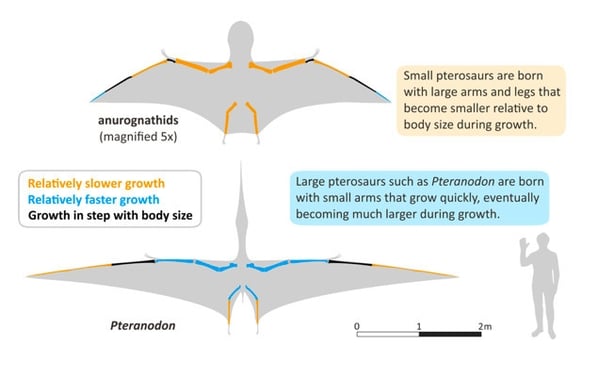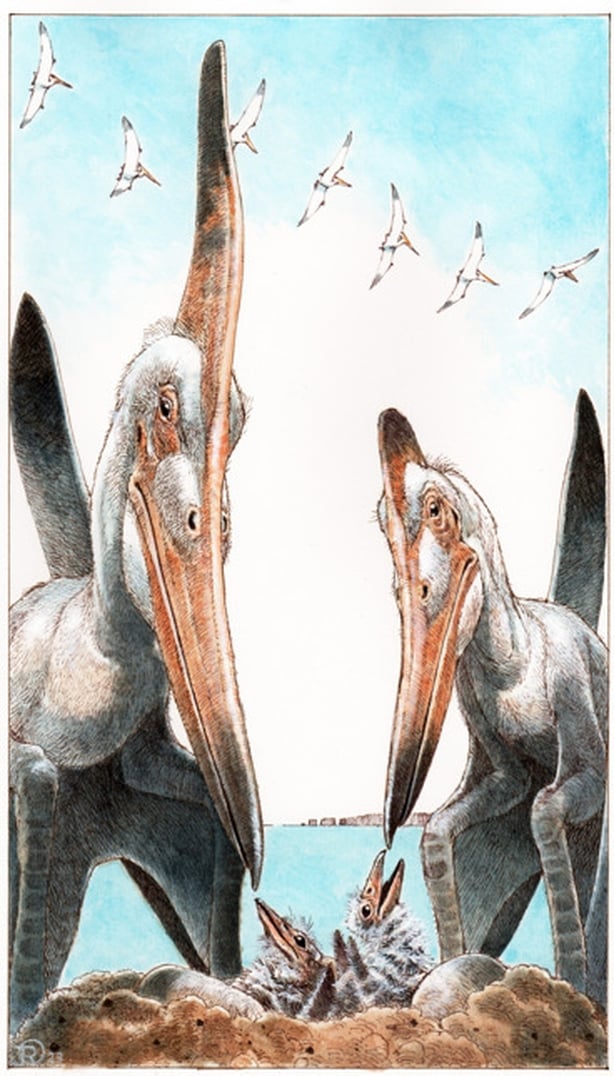By Zixiao Yang, UCC and David Hone, Queen Mary University of London
Pterosaurs are those amazing flying creatures from the background of dinosaur movies, but they never seem to get to star. They were though, the first vertebrates to conquer the sky, beating birds and bats by about 100 and 150 million years, respectively. And yet, pterosaurs produced the largest airborne animals with wingspans up to 10m.
Meet the baby pterosaur
In the early days, pterosaurs were pictured as being very birdlike. They were typically assumed to be altricial like most birds – they nest and care for their offspring, which grew quickly and then only flew after growing up. Pterosaurs do resemble birds in many ways, such as their elongated wings, hollowed bones, long jaws and sharp claws. And, as scientists later learned, pterosaurs are very close cousins of dinosaurs which eventually gave rise to birds.
But this view of pterosaur ecology has changed dramatically in recent decades. Pterosaurs were found to be highly precocial like reptiles, with very limited parental care and juveniles ready to live (and fly!) on their own soon after hatching. Notably, pterosaur eggs were thin shelled, making them soft and leathery like reptile eggs. Pterosaur parents therefore were not able to sit on their eggs to incubate - they buried their eggs in a humid nest of rotting leaves, as some reptiles do today.
We need your consent to load this rte-player contentWe use rte-player to manage extra content that can set cookies on your device and collect data about your activity. Please review their details and accept them to load the content.Manage Preferences
From RTÉ Radio 1's Drivetime, Prof Maria McNamara from UCC on how pterosaurs had the genetic machinery to change the colour of their feathers
Furthermore, pterosaur embryos (and babies) show well-developed limbs ready for action. Many of the wing bones were fully formed hard bones and the elongated wing shape, characteristic of pterosaurs, had already developed. In fact, relative sizes of the wing bones were similar to, or even larger than, those of adults.
This is in sharp contrast to birds. Most baby birds have very small, useless wings – these only become large enough for flight at or near adult sizes. Given the well-developed wings in baby pterosaurs, they probably used their wings very early on. Indeed, palaeontologists have studied the bone strength and aerodynamics of several pterosaurs and found that even their hatchlings were capable of powered flight.
In line with this 'fly-early' idea, there is also evidence that juveniles were able to feed themselves. In many pterosaurs, their neck and jaw became more elongated during growth; most toothed pterosaurs added more teeth and some also changed their tooth shape. These changes in the food-gathering anatomies suggest that pterosaurs gradually changed diets during growth, like alligators do today.

But did all pterosaurs grow up this way? Although all pterosaurs hatched from relatively small eggs (given the poorly hardened eggshell), only some were able to grow to be giants. The giant pterosaurs must have been doing something different. Unfortunately, we know little about how giant pterosaurs grew up – until now.
How some pterosaurs became giants
Our new research reveals that at least some giant pterosaurs indeed were growing differently. While small pterosaurs were born with large, well-developed wings, giant pterosaurs such as Pteranodon (that could reach 8m in wingspan) were born with proportionally smaller arms and thigh bones. These bones, and the associated muscles, are critical for powering both flight and terrestrial locomotion.
Their delayed development indicates that Pteranodon youngsters were not flight ready as those of the smaller pterosaurs – they probably required high-input parental care. This makes more sense than giant pterosaurs having very independent offspring. For pterosaurs to grow bigger, they would need faster and/or longer growth. Having very independent offspring however, is not good for either.

Juveniles are easy targets of predators; pterosaurs juveniles also had suffered from high rates of flight accidents, just like fledging birds that are still learning to master flight. Such a treacherous path through growth as independent offspring would lead to natural selection for a shortened period of growth.
Independent juveniles also have slower growth rates. If an animal is actively flying for food or evading predators, a big chunk of the energy intake will be spent in the process and little will go to contributing growth. Further, between fast growth and early function, 'warm-blooded' animals can only focus on one thing. This probably also applies to pterosaurs as they had a comparable level of physiology.
High-input parental care therefore is a more sensible strategy for pterosaurs to become giants. This way, the youngsters can grow for longer periods of time while maintaining a high growth rate.
There was probably more variety than this going on in the pterosaurs as a whole, since we have only been able to analyse a few species so far. After all, pterosaurs lived on earth far longer than any of the other winged vertebrates and had evolved an unparalleled diversity of body sizes.
Dr. Zixiao Yang is a Postdoctoral Researcher in the School of Biological, Earth & Environmental Sciences at UCC. Dr David Hone is a Reader in Zoology and Deputy Director of Education at the School of Biological and Behavioural Sciences at Queen Mary University of London.
The views expressed here are those of the author and do not represent or reflect the views of RTÉ

